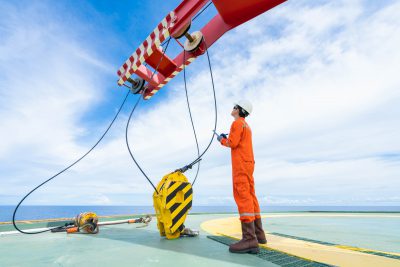
If you need assistance with construction safety and OSHA Citations as discussed in this article call us at 973-366-4660 or email us at info@atlenv.com for details and a free estimate.
Written By:
Robert E. Sheriff, MS, CIH, CSP, President
August 10, 2018
Construction safety, that is, injuries and illnesses at construction sites, have been getting increased attention from OSHA Inspectors. Each year, OSHA compiles the Top 10 List of Citations to increase awareness of the most commonly found safety issues and reduce preventable injuries and illnesses. In 2013, 40% of the citations were from construction regulation violations. This is consistent with the top ten lists in past years. (OSHA’s fiscal 2017 is October 1, 2016 to September 30, 2017).
The Construction Standards apply to all types of construction: roads, high rises, demolition, housing, reclamation, public works, and renovation.
The 2017 Top 10 Citations By Specific Standard Are:
| Standard | Part Number29 CFR | Construction or General Industry |
| 1. Fall Protection | 1926.501 | Construction |
| 2. Hazard Communication | 1910.1200 | General |
| 3. Scaffolding | 1926.451 | Construction |
| 4. Respiratory Protection | 1910.134 | General |
| 5. Control of Hazardous Energy (Lock-Out/Tag-Out) | 1910.147 | General |
| 6. Ladders | 1926.1053 | Construction |
| 7. Powered Industrial Trucks | 1910.178 | General |
| 8. Machine Guarding | 1910.212 | General |
| 9. Fall Protection | 1926.503 | Construction |
| 10. Electrical, General Requirements | 1910.303 | General |
The following is a more detailed listing of common citations in each of these OSHA standards:
- Fall Protection
- Failure to install fall protection at 6 feet above level.
- Hazard Communication
- A written hazard communication program had not been developed, implemented, or maintained.
- Material Safety Data Sheets were not available for each hazardous chemical used.
- Containers of hazardous chemicals did not identify the contents.
- Scaffolding
- Not having the scaffold deck fully floored.
- Not having the scaffold level or capable of supporting its designated load with the proper use of screw jacks, footings, etc.
- Not providing safe access for each scaffold.
- Not providing proper fall, or falling object, protection — guardrails, mid-rails, toe boards, screens and debris netting.
- Not having scaffold components approved by a competent person on the job site.
- Not having the scaffold inspected daily.
- Respiratory Protection
- Failure to establish written respiratory program.
- Failure to provide medical evaluations to determine employee ability to use a respirator.
- Failure to provide respirators.
- Control of Hazardous Energy (Lock-Out/Tag-Out)
- Failure to have a written lock-out tag-out program that complies with the standard.
- Exposure of employees to energized machines or equipment during service maintenance operations.
- Failure to train employees in lock-out/tag-out safety procedures.
- Failure to develop procedures, documented and utilized for the control of potentially hazardous energy when employees are engaged in the activities covered by this section.
According to OSHA, a Lock-Out/Tag-Out Program must include three basic elements:
a) Written procedures for controlling hazardous energy releases from each piece of equipment. They should describe preparation for shutdown, actual shutdown, and equipment isolation, steps for applying and removing lock-out/tag-out devices, requirements for testing/sampling that hazardous energy has indeed been isolated, and notification of employees.
b) Training for “authorized” employees who do the maintenance and servicing work and must know how to safely isolate energy sources before beginning work; “affected” employees who might be working in the vicinity of a locked-out machine and must understand the hazards of attempting a start-up; and “other” employees who might be walking through part of a plant where a machine is locked out.
c) Periodic audits, at least once a year, of the overall program. This inspection must be done by an authorized employee who is not actively involved in the energy control procedures being inspected.
The standard does not cover normal production operations, such as routine adjustments, which are covered by OSHA’s machine guarding standards. Also excluded are hot tap operations involving gas, steam, water or petroleum products where shutdown is impractical and other documented procedures guarantee worker safety. Furthermore, the standard does not apply to work on equipment powered through a cord and plug when it is unplugged and the authorized employee has complete control over the plug.
- Ladders (1926.1053)
- The top or top step of a step ladder shall not be used as a step.
- Not having adequate tie off of ladder that extends less than 3 feet above upper landing surface to which the ladder is used to gain access to.
- Carrying an object up a ladder that could cause the employee to loose balance and fall.
- Powered Industrial Trucks
- Failure to provide adequate training. The employer must ensure that the employee is competent to operate a powered industrial truck, as demonstrated by successful completion of a training program and evaluation.
- Machine Guarding
- Failure to provide adequate guarding in equipment that can cause injury due to belts, gears, shafts, pulleys, sprockets, spindles, drums, fly wheels, chains, or other reciprocating, rotating or moving parts of equipment.
- Fall Protection – Training
- Failure to train employees in fall protection safety procedures.
We have 40 years of experience in construction safety including program development, site inspections, training, and regulatory interpretation. Our staff includes Certified Safety Professionals and Certified Industrial Hygienists and Field Inspectors. For more information or a specific quotation e-mail us at info@atlenv.com or call 973-366-4660.
Our primary service areas for Construction Safety Services are: NJ, NY, NYC, PA, CT, DE, MA, RI, Wash DC, WI, MD, MI, IL, VA, IN, GA, AL, NC, SC, TN, TX, OK, DC, AR, we can service most other areas of the U.S. but with some added travel charges.



